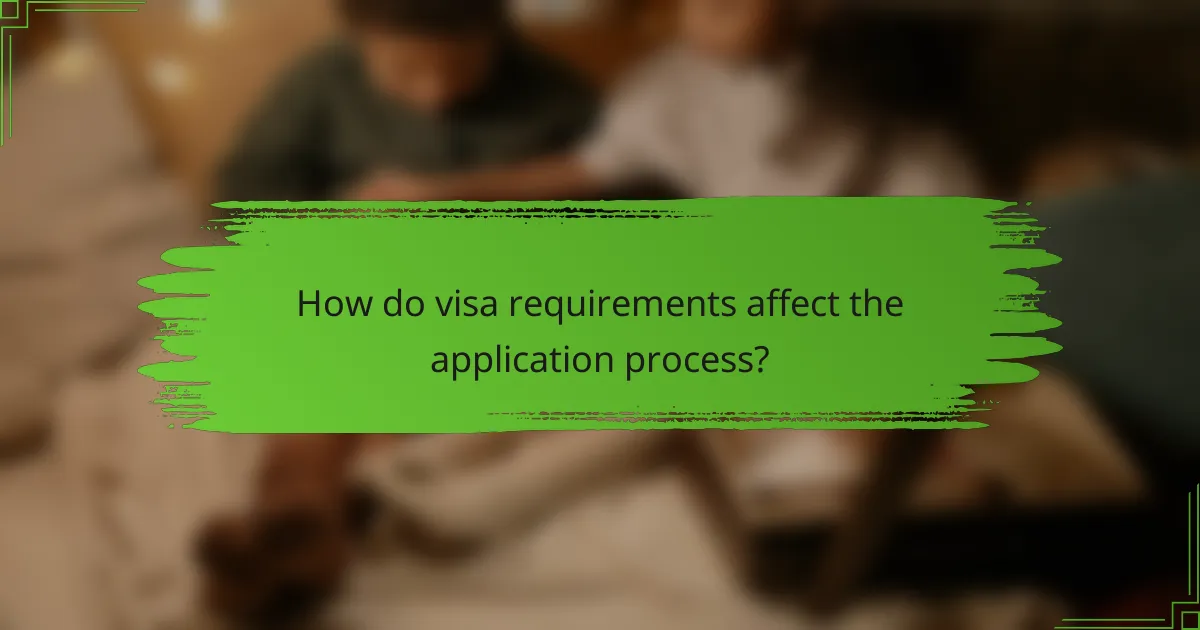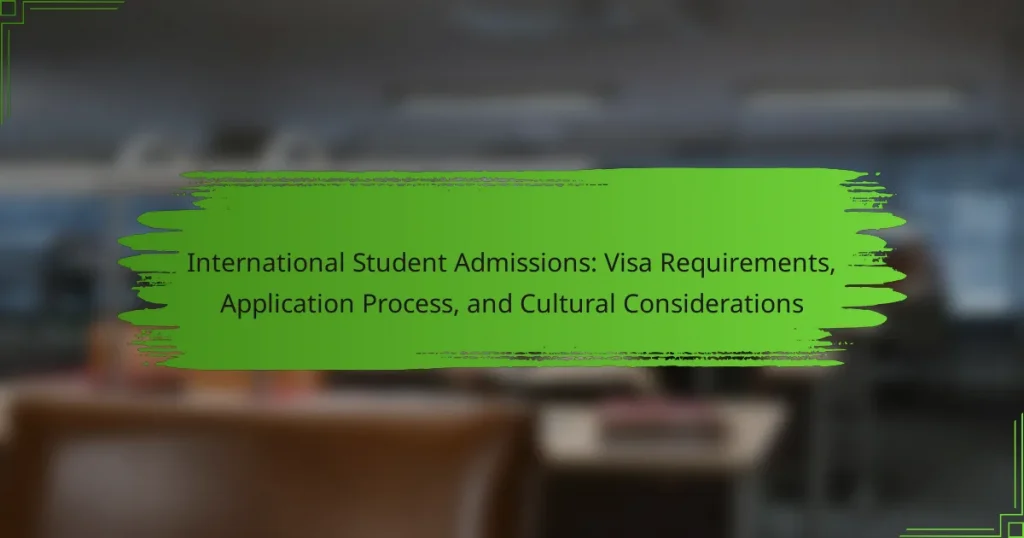
What are the key aspects of International Student Admissions?
Key aspects of International Student Admissions include eligibility criteria, documentation requirements, and application procedures. Eligibility criteria often involve academic qualifications and language proficiency tests. Documentation typically requires transcripts, letters of recommendation, and proof of financial support. The application process may vary by institution and often includes submission deadlines and interview requirements. Visa requirements are crucial, as students must obtain a student visa to study abroad. Cultural considerations also play a role, as understanding the host country’s culture can aid in the transition. Institutions may offer orientation programs to help international students acclimate.
What are the primary visa requirements for international students?
International students must meet specific visa requirements to study abroad. These typically include obtaining a valid acceptance letter from an accredited institution. Students must also demonstrate sufficient financial resources to cover tuition and living expenses. A valid passport is essential, along with completing the appropriate visa application form. Some countries require proof of English language proficiency. Additionally, students may need to undergo a medical examination or provide health insurance documentation. Visa requirements can vary by country, so it is crucial to check the specific guidelines of the destination.
What types of student visas are available for international students?
The types of student visas available for international students include F-1, M-1, and J-1 visas. The F-1 visa is for academic students enrolled in a full-time program. It allows students to pursue degrees at colleges and universities. The M-1 visa is for vocational or non-academic students. This visa is designed for those attending technical or vocational schools. The J-1 visa is for exchange visitors participating in programs that promote cultural exchange. Each visa type has specific eligibility criteria and application processes. For instance, the F-1 visa requires students to be enrolled in a SEVP-approved institution.
What documents are needed to apply for a student visa?
To apply for a student visa, specific documents are required. These typically include a valid passport, a completed visa application form, and proof of acceptance from an educational institution. Financial evidence demonstrating the ability to cover tuition and living expenses is also necessary. Additionally, applicants may need to provide academic transcripts and standardized test scores. A passport-sized photograph and a statement of purpose can be required as well. Some countries may ask for a medical examination report or proof of English language proficiency. These documents ensure that the application meets the requirements set by immigration authorities.
How does the application process for international students work?
The application process for international students typically involves several key steps. First, students must choose a program and institution that suits their academic goals. Next, they complete the application form provided by the institution. This often includes submitting academic transcripts, letters of recommendation, and a personal statement.
International students may also need to demonstrate English language proficiency through standardized tests, such as TOEFL or IELTS. After submitting the application, students await an admission decision, which can take several weeks. Upon acceptance, students receive an admission letter, which is essential for visa applications.
Finally, students must apply for a student visa, providing necessary documentation, including proof of acceptance and financial support. The entire process can vary by country and institution, but these steps are generally consistent across many educational systems.
What are the steps involved in applying for international student admission?
The steps involved in applying for international student admission include researching institutions, preparing required documents, submitting applications, and obtaining a student visa. First, prospective students should identify schools that offer their desired programs. Each institution has specific admission requirements. These often include academic transcripts, standardized test scores, and letters of recommendation.
Next, students must complete application forms, which may be submitted online or by mail. After submission, students should await acceptance notifications. Once accepted, they will receive an admission letter necessary for visa applications.
Finally, students must apply for a student visa, which involves providing proof of acceptance, financial support, and sometimes medical examinations. Following these steps ensures a smoother admission process for international students.
How can students prepare for the admission application?
Students can prepare for the admission application by researching their target institutions thoroughly. They should understand the specific requirements for each program. Gathering necessary documents is crucial. This includes transcripts, letters of recommendation, and personal statements. Students must also prepare for standardized tests if required, such as the TOEFL or IELTS for non-native speakers. Creating a timeline for application deadlines helps in staying organized. Additionally, seeking feedback on application materials can improve quality. Finally, staying informed about visa requirements is essential for international students.
What cultural considerations should international students keep in mind?
International students should consider local customs and social norms. Understanding greetings, personal space, and communication styles is crucial. Different cultures have varying levels of formality and directness in interactions. Students should also be aware of dietary restrictions and social etiquette surrounding meals. Academic expectations may differ, including participation and classroom behavior. Students must respect local laws and cultural practices. Engaging in cultural exchange enhances the experience and fosters understanding. Research indicates that cultural adaptation improves academic performance and social integration.
How do cultural differences impact the international student experience?
Cultural differences significantly impact the international student experience. These differences affect communication styles, social interactions, and academic expectations. For instance, students from collectivist cultures may prioritize group work over individual performance. In contrast, students from individualistic cultures might focus on personal achievements. Language barriers can also create challenges in understanding course material and participating in discussions. Additionally, varying norms around punctuality and classroom etiquette can lead to misunderstandings. Research shows that students who adapt to cultural differences report higher satisfaction and academic success. A study by Mazzarol and Soutar (2002) found that cultural adaptability is a key factor in international students’ overall experience.
What resources are available to help international students adapt to a new culture?
International students can access various resources to help them adapt to a new culture. Universities often provide orientation programs that introduce students to local customs and social norms. These programs facilitate networking with other international students, creating a support system. Language exchange programs enhance communication skills and cultural understanding. Counseling services are available for emotional support during the transition. Additionally, cultural clubs and organizations promote engagement with the local community. Workshops on cultural sensitivity and adjustment strategies are also offered. These resources are designed to ease the cultural transition and enhance the overall experience of international students.

How do visa requirements affect the application process?
Visa requirements significantly influence the application process for international students. They dictate the necessary documentation needed to apply for a visa. Common requirements include proof of acceptance from an educational institution, financial statements, and health insurance. These requirements can vary by country and may change based on international relations. The complexity of these requirements can lead to delays in the application process. Additionally, students must often navigate specific forms and interviews, which can add to the time needed for approval. Compliance with these requirements is essential to avoid visa denials, impacting students’ ability to study abroad. Overall, visa requirements play a crucial role in shaping the timeline and success of the application process for prospective international students.
What role do visa requirements play in international student admissions?
Visa requirements are critical in international student admissions. They determine whether a student can legally enter and study in a foreign country. Each country has specific visa regulations that applicants must meet. These regulations often include proof of acceptance into an educational institution, financial stability, and language proficiency. Failure to meet visa criteria can lead to application rejection. Additionally, visa processing times can impact the overall admission timeline. Delays in obtaining a visa may hinder a student’s ability to start their studies on time. Thus, understanding and fulfilling visa requirements is essential for successful international student admissions.
How can students navigate visa challenges during their application?
Students can navigate visa challenges during their application by thoroughly understanding visa requirements. They should research specific visa types and associated documentation needed for their destination country. Gathering necessary documents in advance can prevent delays. Consulting with the international student office at their institution provides tailored guidance. Joining online forums or groups can offer peer support and insights. Additionally, students should keep track of application deadlines to ensure timely submissions. Engaging with immigration lawyers can clarify complex legal questions. Staying informed about changes in immigration policies is crucial for compliance.

What are the best practices for international student admissions?
Best practices for international student admissions include clear communication, comprehensive guidelines, and timely processing. Institutions should provide detailed information on application requirements and deadlines. This helps students understand what is expected of them. Additionally, offering support services for visa applications is crucial. It ensures students navigate legal requirements successfully. Establishing a dedicated admissions team can enhance the experience for international applicants. This team can address questions and provide personalized assistance. Furthermore, engaging with prospective students through webinars and virtual tours can foster a sense of connection. Research indicates that institutions with strong support systems see higher enrollment rates among international students.
What tips can help streamline the application process for international students?
Start early to gather necessary documents. This includes transcripts, letters of recommendation, and proof of language proficiency. Create a checklist of requirements for each institution. This ensures nothing is overlooked. Use online application portals for efficiency. They often provide guidance and track progress. Seek assistance from educational consultants if needed. They can clarify complex requirements. Join forums or groups for international students. These communities share valuable insights and experiences. Lastly, stay organized with deadlines. Missing a deadline can delay the entire process.
How can students effectively gather required documentation?
Students can effectively gather required documentation by creating a checklist of necessary items. This checklist should include transcripts, letters of recommendation, and proof of language proficiency. Students should also contact their previous educational institutions for official documents. Utilizing online resources can help locate specific requirements for different countries. Engaging with admissions offices can clarify any uncertainties about documentation. Setting deadlines for each document can keep students organized. Additionally, using a secure storage method for digital copies can prevent loss. Following these steps ensures students have all necessary documentation for their applications.
What strategies can assist in adapting to a new cultural environment?
Engaging with the local community is a key strategy for adapting to a new cultural environment. This involves participating in cultural events and activities. Joining local clubs or organizations can also facilitate connections. Learning the local language enhances communication and understanding. It is beneficial to seek out cultural exchange opportunities. Building relationships with locals fosters a sense of belonging. Understanding cultural norms and values is crucial for effective interaction. Researching the history and customs of the new culture provides context.
What common pitfalls should international students avoid during the admissions process?
International students should avoid several common pitfalls during the admissions process. One major mistake is missing application deadlines. Many institutions have strict timelines for applications and supporting documents. Another common issue is inadequate research on universities. Students must understand program specifics and campus culture. Failing to meet language proficiency requirements can also hinder admissions. Many schools require standardized test scores or language tests like TOEFL or IELTS. Additionally, not securing proper financial documentation can lead to application rejection. Students must provide proof of sufficient funds for tuition and living expenses. Lastly, neglecting to tailor personal statements can weaken applications. A generic essay may fail to showcase individual strengths and motivations. By addressing these pitfalls, international students can enhance their chances of successful admissions.
International Student Admissions encompass the eligibility criteria, documentation requirements, and application procedures necessary for students seeking to study abroad. Key aspects include visa requirements, which dictate acceptance letters, financial proof, and language proficiency, as well as the types of student visas available, such as F-1, M-1, and J-1. The article outlines the application process, cultural considerations for adaptation, and best practices to streamline admissions, emphasizing the importance of understanding visa regulations and preparing required documentation to ensure a successful transition into a new academic environment.




